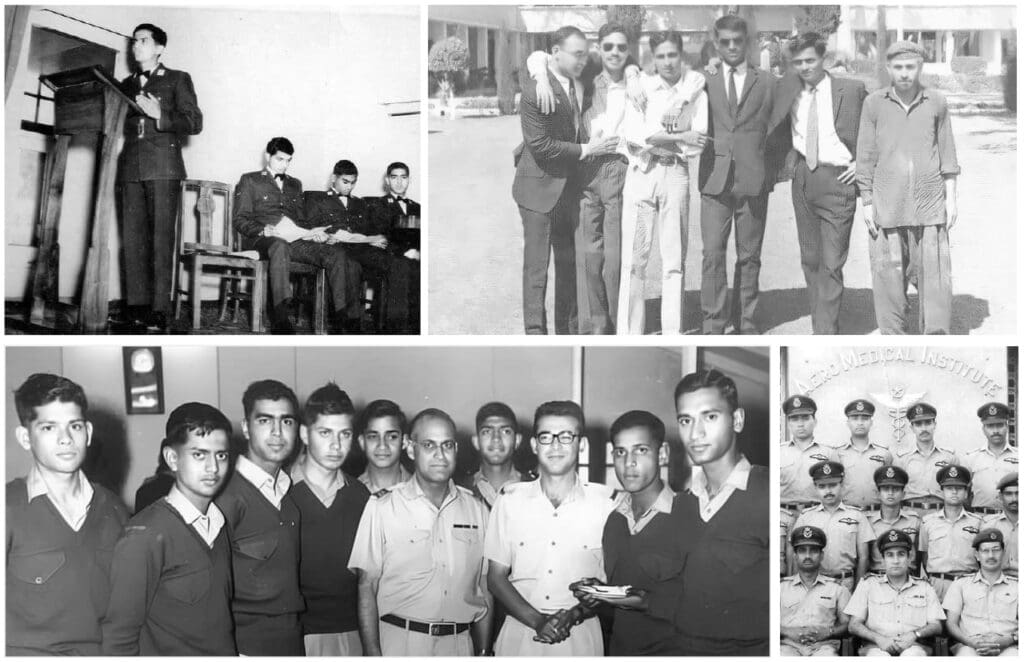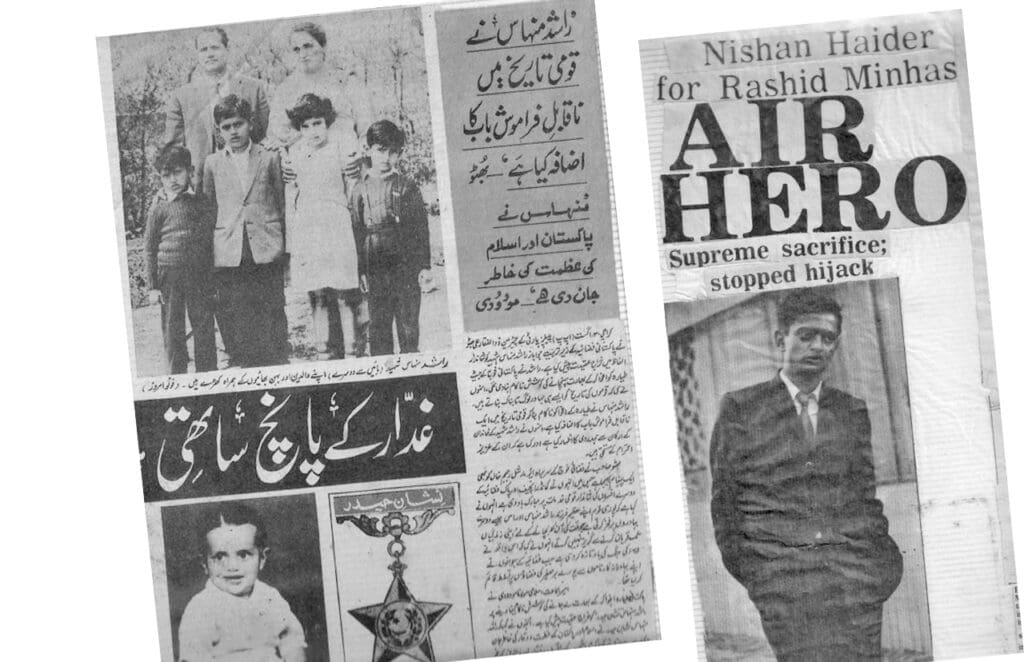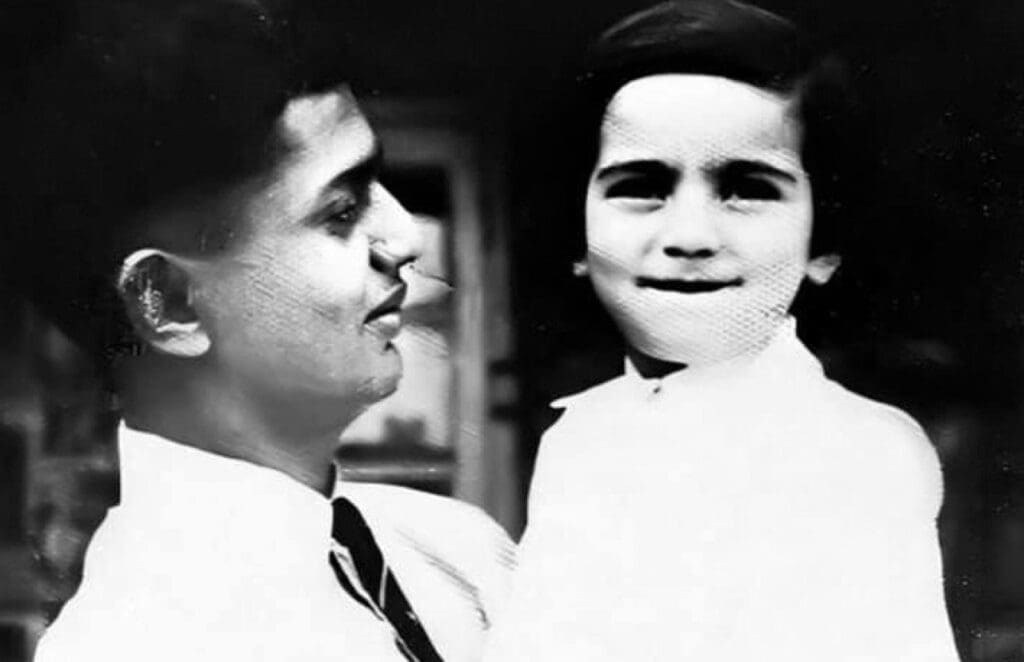Rashid Minhas remains an enduring symbol of valour. In the pivotal year of 1971, at the tender age of 20, Minhas found himself in a situation that would forever etch his name in the annals of heroism. Confronted by a treacherous attempt to hijack his aircraft, he displayed extraordinary resolve by refusing to surrender control of the plane to the would-be hijacker. Instead, he chose to make the ultimate sacrifice, embraced martyrdom and stopped his aircraft from falling into enemy hands. The first and only PAF man to receive the honourable Nishan-e-Haider, Rashid Minhas’s legacy lives on to this day.

Amidst the Minhas clan, a sub-shoot of the illustrious Rajputs, a young soul took his first breath on 17 th Feb, 1951. He opened his eyes in Karachi, in the home of Abdul Majeed, a respected civil engineer. From the bustling streets of Karachi, his family’s journey led them to Lahore and then to the charming city of Rawalpindi. It was during his formative years at St. Mary’s Academy that Rashid’s fascination with aviation history and aero-modelling began to flourish. In an entry dated 7 Aug 1965, he wrote in his diary, “Today I promise from my heart that out of three defence forces, I will definitely join any one.”
His parents, at the time, had no idea of young Rashid’s concealed fervour. They wanted him to follow in his father’s footsteps and become an engineer. However, once Rashid revealed his plans, they gave in, sensing the unrelenting nature of his decision. Once he had sights locked on his eventual goal, Rashid Minhas whizzed through O and A levels and quickly joined PAF College Lower Topa for his initial training.
He was passionate about soaring among the clouds, free of all restraints. This time finally came, when he joined 51 GD (L) course at PAF Academy Risalpur in Aug 1969. In the academy, he grabbed every single opportunity to be airborne, absorbing information like a sponge from his instructors while on the ground. He completed his primary and secondary flying training on Harvard and T-37 aircraft, proving himself to be a promising pilot from the get go.
His efforts paid off and he finally earned his wings on 14 March, 1971. It was a proud moment for him and his family. The first order of business was a conversion course on the T-33. He joined the No 2 Sqn, which unbeknownst to him at the time, would later boast about having him as their comrade for decades to come.
The conspiracy
This tale has a hero. But depending on which soil you call your own, the name changes. For Pakistan, its Rashid Minhas. For Bangladesh, the man was Mati ur Rehman, a PAF flying instructor hailing originally from Dhaka.
In 1971, the army initiated ‘Operation Searchlight’, a counter-insurgency operation in East Pakistan. As a precautionary measure, Bengali officers and men were restricted and kept a strict eye on for fear of treason or sabotage. The same applied to PAF. It was a tough decision but one that PAF was forced to take at the time. As the scenario spiralled out of control, flying privileges and equipment was taken away from the Bengali pilots and crew. This new humiliating restriction was the final nail in the coffin. Multiple conspiracies began to hatch in different locations.

One of these locations was the Masroor Air Force Base in Karachi. The Bengali personnel wanted a plan which would simultaneously damage PAF’s capabilities and alert the world to Bengal’s freedom movement. The group met in small, secretive gatherings, wary of the intelligence units who were on high alert. It was decided that hijacking an aircraft and defecting it to Bangladesh was the most suitable way to accomplish their goals.
The first aircraft of choice was the F-86 Sabre. But gaining access was almost impossible and starting up a Sabre without a proper crew and equipment was a difficult task. Thus, the idea was dropped. The next target was a two-man aircraft about to be flown by a trainee. A T-33 that the trainee usually flew was a valuable enough aircraft. Next, it was to be decided who would be the trainee and, more importantly, who would be the hijacker. Rashid Minhas’s name was finalized as the trainee, as the conspirators grossly underestimated his resolve. Mati ur Rehman was selected as the man who would carry out the deed.
Mati ur Rehman was a pilot hailing from Dhaka. He passed the PAF Sargodha entrance exam and moved to West Pakistan in 1956. Becoming a competent pilot, he quickly rose through the ranks and was appointed as a Flying Instructor at PAF Base, Masroor in 1971. Before the deed, Mati ur Rehman flew to Dhaka along with his family in January, 1971. The details of his stay there can be found on the official Bangladesh Air Force website. He flew back to Pakistan on 9th May. On the base, although he was grounded like his colleagues, he still enjoyed the privilege of being the Ground Safety Officer. His main duties included aircraft maintenance and operations. This was the perfect cover for the task he had taken upon himself. His wife was also a sociable person, getting along nicely with the wives of the other personnel. All these factors made him the perfect candidate for the treacherous plot.
His sole concern about the entire operation was the safety of his family. He was assured that his wife and daughters would be moved to the Indian consulate a day before the deed.
The day:
Oblivious of the events that the day had in store for him, Rashid Minhas relaxed in the mess. He ordered his breakfast in a leisurely manner. He was in no hurry. He wasn’t scheduled to fly that day, so he could take his time. Earlier in the day, it had been decided that the visibility levels were not safe for solo training missions. The pilots who were due for dual-flying missions were checking their schedules, so they could get the briefing from their respective instructors. One of these pilots noticed Rashid Minhas’s name on the board, due for a ‘Solo Consolidation’ mission.

Rashid Minhas was waiting for his breakfast when he was told about the change. He quickly jumped up and told the staff to cancel his breakfast. He rushed to his flying instructor Flt Lt Hasan Akhtar, who gave him a mission briefing for the day’s mission. After changing into his pilot gear, he decided that although he didn’t have enough time for a full breakfast, he could manage to have a few gulaab jamuns, one of his favourite snacks. One of the last people with whom he interacted was Plt Off Tariq Qureshi, a close friend. He shared a few sips of a cold drink with him before heading out before the take- off time, which was 1130 hrs. “That was the last we saw of him, munching snacks on his way out,” remembers Qureshi. Rashid Minhas went through the check-ups. With the call sign Bluebird-166’, Rashid Minhas’s T-33 taxied out of the main tarmac.
After this, a substantial chunk of the events that transpired between Rashid Minhas and Mati ur Rehmanare speculated using physical evidence. In all probability, Mati ur Rehman had appeared in Rashid Minhas’s view before he could take off, gesturing to him to stop his aircraft using some fake excuse. Seeing one of the instructors stopping him, Rashid Minhas must have thought that it must be some new, important information about the mission. Once still, Rashid Minhas must’ve thought that Mati ur Rehman would probably communicate with him on the intercom. Instead, Mati ur Rehman, not burdened by the heavy flying equipment, possibly stepped on to the aircraft’s wing and entered the aircraft’s rear cockpit.
The T-33 does not have a seat cushion. The pilot is supposed to use his parachute as a seat cushion. Mati ur Rehman wasn’t equipped with a parachute when he climbed in. This means that it would’ve made controlling the aircraft a much more difficult task from the rear cockpit. It can be safely assumed that he needed Rashid Minhas’s compliance to achieve his nefarious goals. This he probably achieved by using a replica pistol, which was later retrieved from the wreckage.
Exactly at 1128 hrs, the ATC Tower received a disturbing call, “Bluebird 166 is hijacked!”. Immediately afterwards, the T-33 took off from runway 27 at 1130 hrs. Once airborne, the T-33 turned left and started steering 120 degrees. During this time, Rashid Minhas was able to make two more desperate calls to the ATC, repeating that his plane had been hijacked. These were the last words heard from the T-33.
In the ATC, Flt Lt Asim Rasheed had just received the call that no controller ever hoped to receive. The reality finally sank in when the T-33 took an unusual turn and flew down to dangerous levels. He called the Sector Operations Centre (SOC) and gave him the news. However, the SOC started demanding details. Asim Rasheed made a judgement call, hung up on the SOC and immediately made a call to the Air Defence Alert (ADA) Hut.
“A T-33 has been hijacked! Scramble!” he ordered.
The call was heeded by Wg Cdr Shaikh Saleem, OC of No 19 Squadron. He rushed to his F-86 with his wingman, Flt LT Kamran Qureshi, as No 2. Kamran Qureshi took off first, followed by the leader. The biggest problem, however, was that the SOC had no clue about the location of Rashid Minhas’s aircraft.
The low level that it had dropped down to was not just to elude visual spotting, it also ensured that the aircraft did not show up on radar. Another pair that was scrambled to intercept the T-33 was Flt Lt Abdul Wahab and Flt Lt Khalid Mehmood.

Wahab recalls the incident in these words, “We knew something was wrong, we had seen the aircraft taxiing dangerously fast. After we got airborne, there was a lot of confusion. Nonetheless, we gave fake calls on ‘Guard’ channel that the F-86s were behind the T-33, and it would be shot down if it did not turn back. However, with no real prospects of scaring Mati ur Rehman with warning bursts from the F-86’s guns, the only option that remained was to order Minhas to eject. A flurry of radio calls then started, asking Bluebird-166 to eject. There was no response, but the calls continued for several minutes, being repeatedly transmitted by the F-86s, as well as the SOC.”
In the hijacked T-33, Rashid Minhas and Mati ur Rehman were locked in a deadly struggle. Each tried to overpower the other. The trainer T-33 had inter-linked flight controls, which complicated the scenario greatly. Mati ur Rehman was hell bent on flying the T-33 to India. However, Mati ur Rehman had not factored in the resolve of Rashid Minhas. The wiry, young pilot that the conspirator thought would be easily overpowered proved to be a force of nature. He staunchly refused, trying his best to not let Mati ur Rehman have his way. The deadlock continued as the aircraft neared the Indian border.
As the point of no return came closer, Rashid Minhas knew he could never let the aircraft cross the border. In the chaos, he came to the conclusion that he had no choice. It was the moment of truth for the young pilot who had the courage to do which even veteran pilots might not have been able to.
Some 51 kilometres away from the Indian border, Rashid Minhas deliberately dipped the T-33 and crash landed near Thatta. The estimated time of the crash was 1143 Hrs. The young ace had given his life to stop an aircraft falling into the hands of the enemy. Back at the base, the news had spread like wildfire. Most speculated that the hijacking had been successful. A phone call from Shah Bandar cleared the dreadful mystery. It was reported that an aircraft had crashed near the region. There were no survivors. The search and rescue helicopter was dispatched immediately. The men located the aircraft at a distance of 64 nautical miles from Masroor, on a heading of 130°. The tail of the T-33 numbered 56-1622 could be seen sticking out of the water-logged, soft muddy terrain at the mouth of Indus River, just 32 nautical miles short of the border.
The honour given to the martyr
Coincidentally, the Air Chief Rahim Khan was hosting President Yahya Khan at lunch in Peshawar when he received the call. He filled Yahya Khan with the details and suggested that Rashid Minhas be presented with Sitara-e-Jurat. Yahya Khan’s memorable response was, “Why only a Sitara-e-Jurat? The boy deserves nothing less than a Nishan-i-Haider!”

The Air Chief was pleased. The announcement was made the same day and Rashid Minhas became the youngest recipient and the only one from the air force to receive the prestigious Nishan-i-Haider. Rashid Minhas quickly became a national hero in Pakistan. The former Air Chief Marshal Asghar Khan and the then Air Chief Marshal Rahim Khan were greatly moved by the tragic loss. They both penned down separate letters to Rashid’s father, condoling him on the death of such a fine son and acknowledged the supreme sacrifice made by the young hero. Another great honour was the renaming of PAF Base at Kamra, which was renamed to PAF Base Minhas. In Karachi and several other cities, boulevards have been named after him. In Dec 2003, Pakistan post issued a two-rupee postage stamp in his honour. A staggering 500,000 tickets were printed and sold-out within a few days. Shahzad Khalil took it upon himself to visualize the entire incident in a teleplay titled ‘Rashid Minhas’. It was broadcasted on PTV during the 80s. It was a beautifully written and directed teleplay.
His last resting place
Rashid Minhas (NH) rests in Fauji Qabiristan in Karachi. Situated right next to the famous Gora Qabiristan, the cemetery is the final abode of the hero.
On the headstone, an apt and beautiful piece of Urdu poetry has been engraved. It translates to:
Though they both fly through the same breeze,
The trail of a follower is different from the trail of a defector.
Rashid’s martyrdom translates into Iqbal’s verse,
The flying domain of a hawk is different from that of a vulture.








